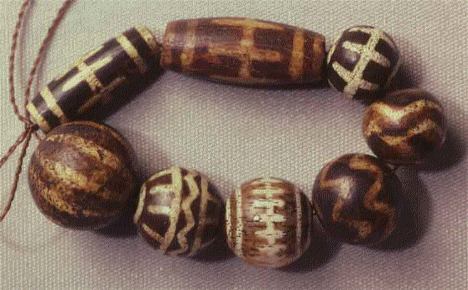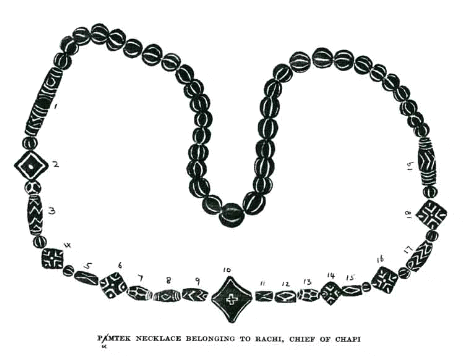|
|||||||||||||||||
|
PYU PICTORIAL & ESSAY FOR BEADCOLLECTOR.NET December 17, 2005 by Jamey D. Allen Intro In the Summer of 1988, I received a call from Elizabeth Harris in Los Angeles. She was excited by the news that beads from Burma were in the radar. Burma had been a closed country for a long time, and it was unusual for anyone to go there, let alone to bring items out. I caught her excitement, as she explained to me that Judith Ubick, another Bead Society member, was working for a client who had a large quantity of ancient beads, that had been brought out of Burma. The person who sold them to the dealer said the "archaeologist" was not interested in the beads, and allowed him to have them. [Of course, we may never know how many details of the story are true, but some of it is fishy.] Judy had been hired to use the beads in necklace designs for the new owner, who is an antiques dealer in Palos Verdes. This was no easy task, since many of the beads had impacted perforations--full of very hard dirt that was difficult to remove. Nevertheless, Judy strung-up a nice variety of necklaces. It occurred to her that these were such great and unusual beads, and there were so many, that she convinced the owner to donate a selection to The Bead Museum. That's why Elizabeth was telephoning me. She and Judy decided it would be great if I were to come down, view the beads, and make the selection for The Museum. I was honored to participate. Two days later, I was on a plane to LAX, met Elizabeth, drove to Judy's, and we began to go over the beads. I was amazed for a number of reasons. The assortment included stone beads, such as crystals, agates, something that looked like green jade, carnelian, decorated beads (like those of India and Persia), and small pumtek beads. Also glass beads imitating the green stone beads and crystals, and Indo-Pacific beads. In 1988 pumtek beads had only been around for five years, having come out of the Indian Hill Tribe region--to an audience that was amazed by them, sometimes compared them to Tibetan zi beads, and had a variety of ideas about their age and origin. If I may digress for a moment, all of this is pertinent to Pyu beads in a significant way. [By the way, Pyu is pronounced "pew"--not "PIE-you."] Pyu beads relate to pumtek beads, pumtek to zi, and zi to "etched" or "decorated agate beads" in general. I was first exposed to zi beads in 1970, reading The Universal Bead by Joan Erikson--who briefly mentioned the 'mysterious tzi beads of Tibet.' In 1974, in the premiere issue of The Bead Journal, Robert Liu wrote a piece on plastic imitations of zi beads. It wasn't until 1979 that I was able (thanks to Liza Wataghani) to see a group of zi beads in real life, and soon thereafter decorated carnelian and black agate beads from Afghanistan (courtesy of Kate FitzGibbon and Andy Hale). Here's a group of them from 1983. |
||
 |
||
|
I had good opportunities to study and document these specimens. That was my beginning--because I have always said, "beads speak to me." I feel I learn much more from an examination of beads than I do from reading something. And, in truth, most of the time when I read something about beads, I come away feeling the author is somewhat inadequate--either from lack of exposure to enough material, or because he or she fails to express the situation well and accurately. Nevertheless, between 1970 and 1980, I did read whatever was available to me about beads--a significant resource being The Bead Journal and Ornament. I also benefitted from discussions I had with Si Frazier (a mineralogist), and other involved bead researchers. Between 1980 and 1983, I voraciously read all of the bead literature I could find, working mainly at the San Francisco Public and UC Berkeley Libraries. Although my main lines of inquiry were about glass-beadmaking, I also read the works of authorities who dealt with Indian and Middle Eastern antiquities, and particularly stone beads. So, in 1983, when pumtek beads showed up at my doorstep, I was surprised, but not unequipped. My friend Tony Anninos, at that time, was bringing art and artifacts back from India and the Himalayas. He would always come to me first, to get my take on his latest finds, to help him make sense of the new wonders he had discovered. We were both blown away by these decorated stone beads, that were sort of like Tibetan zi beads, but also very different. The story had them in the hand of tribal folks in Eastern India, who had formerly lived in Burma. |
||
 |
||
|
I went to UC Library, and proceeded to find several references to the traditional beads of the Chin and Hakachin, that were called "pumtek" beads. Until this time, no one even knew the name of these beads. Here's a plate from N. Perry's book, the Lakhers, from 1932, showing the pumtek necklace of a local chieftain named Rachi. The numbers are there because Perry recorded the names of each type, and what it was used for. |
||
 |
||
|
By 1985, pumtek beads had become almost commonplace, and I was able to purchase several whole strands and necklaces of them. I corresponded with David Ebbinghouse almost weekly about them, and we exchanged a lot of ideas. David intended to write a paper on pumtek beads, similar to his very good article on zi beads for Ornament. However, he kept putting off publication, and I managed to have the first word. I wrote a short article for The Forum--the newsletter of The Society of Bead Researchers, showing the patterns I had documented, and citing a few references. Two of the big questions were, how did this sort of manufacture happen to take place in Burma (assuming this was the original homeland of these beads); and how did they relate to Indian "etched" agates and to Tibetan zi beads? (By the way, 1985 was also the year I participated in the International Bead Conference in Long Beach, and gave a paper on imitation zi beads--particularly plastic imitations.) So, when a group of ancient beads, such as these Burmese beads, became available for contemplation, it provided a LOT of interesting connections. And that's because the group included beads that were clearly from India, and/or were Indian-inspired, had what appeared to be more-or-less typical "etched" carnelians and pumtek beads, AND had specimens that seemed to be intermediary between these two groups. Then, there were the other beads that no one had ever seen before, as well as familiar types that might be seen from almost anywhere in Southeast Asia. As I mention above, I was given an opportunity to photograph beads from this large group, and to select a small group that was given to The bead Museum. A few months later, Judy contacted me again, and said the owner had had all of the necklaces made that she was interested in making--and that I would be allowed to buy some of the remaining beads for my specimen collection. So, in October, Walt Seifried and I went to Judy, and together we made a selection of beads, that we shared. About a year later, Walt bought/traded for all of the remaining beads, directly from the owner in Palos Verdes. I was with him when this transpired. In the following photographs, I will show the variety of this first group of Pyu beads to come into America in 1988. These shots were taken by me at the first meeting, and then in October of the specimens I acquired. |
||
|
|||||||||||